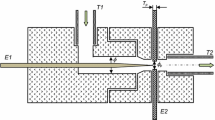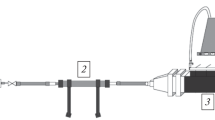Abstract
For this study, a unipolar corona-based ionizer was constructed and experimentally evaluated for charging efficiencies and losses of ultrafine particles in the size range of 15–75 nm at different corona voltage, ion trap voltage and particle flow rate. The corona voltage was applied to the ionizer between 2.0–3.0 kV. The discharge currents increased from 0.16 nA to 4.23 μA and the ion number concentration increased from 6.27 × 109 to 1.36 × 1014 ions/m3. Increasing the corona voltage lead to a higher discharge current and ion number concentration in the ionizer. The best intrinsic charging efficiency of the ionizer was about 92.15–99.33% for particle diameters ranging from 15 to 75 nm, and occurred at corona voltage, ion trap voltage and particle flow rate of about 3.0 kV, 100 V, 0.6 L/min, respectively. At a given corona voltage, the extrinsic charging efficiency increased as the particle flow rate increased. The best extrinsic charging efficiency ranged from 14.93 to 57.70% for particle diameters increasing from 15 to 75 nm, and occurred at corona voltage, ion trap voltage and particle flow rate of about 2.6 kV, 100 V, and 1.5 L/min, respectively. In the present ionizer, the highest electrostatic loss was observed for particles with a diameter of about 45 nm, and it was about 88.03% at a corona voltage of 3.0 kV and an ion trap voltage of 200 V. Finally, the highest diffusion loss of about 22.66% was seen to occur with singly charged particles with a diameter of 15 nm at the particle flow rate of about 0.6 L/min.












Similar content being viewed by others
References
Lee CT, Hsu WC (1996) The source apportionment of urban aerosols from chemical properties of aerosol spectra near atmospheric sources. J Chin Inst Eng 19(1):1–13. https://doi.org/10.1080/02533839.1996.9677760
Flagan RC (1998) History of electrical aerosol measurements. Aerosol Sci Technol 28:301–380. https://doi.org/10.1080/02786829808965530
Intra P, Tippayawong N (2008) An overview of differential mobility analyzers for size classification of nanometer-sized aerosol particles. Songklanakarin J Sci Technol 30(2):243–256
Whitby KT (1961) Generator for producing high concentration of small ions. Rev Sci Instrum 32(12):1351–1355. https://doi.org/10.1063/1.1717250
Intra P, Tippayawong N (2009) Progress in unipolar corona discharger designs for airborne particle charging: a literature review. J Electrostat 67(4):605–615. https://doi.org/10.1016/j.elstat.2008.12.018
Medved A, Dorman F, Kaufman SL, Pocher A (2000) A new corona-based charger for aerosol particles. J Aerosol Sci 31:s616–s617. https://doi.org/10.1016/S0021-8502(00)90625-6
Hernandez-Sierra A, Alguacil FJ, Alonso M (2003) Unipolar charging of nanometer aerosol particle in a corona ionizer. J Aerosol Sci 34:733–745. https://doi.org/10.1016/S0021-8502(03)00033-8
Marquard A, Kasper M, Meyer J, Kasper G (2005) Nanoparticle charging efficiencies and related charging conditions in a wire-tube ESP at DC energization. J Electrostat 63:693–698. https://doi.org/10.1016/j.elstat.2005.03.032
Marquard A, Meyer J, Kasper G (2006) Characterization of unipolar electrical aerosol chargers—Part II: application of comparison criteria to various types of nanoaerosol charging devices. J Aerosol Sci 37:1069–1080. https://doi.org/10.1016/j.jaerosci.2005.09.002
Alonso M, Martin MI, Alguacil FJ (2006) The measurement of charging efficiencies and losses of aerosol nanoparticles in a corona charger. J Electrostat 64:203–214. https://doi.org/10.1016/j.elstat.2005.05.008
Intra P, Tippayawong N (2006) Comparative study on electrical discharge and operation characteristics of needle and wire-cylinder corona chargers. J Electr Eng Technol 1(4):520–527. https://doi.org/10.5370/JEET.2006.1.4.520
Park D, An M, Hwang J (2007) Development and performance test of a unipolar diffusion charger for real-time measurements of submicron aerosol particles having a log-normal size distribution. J Aerosol Sci 38(4):420–430. https://doi.org/10.1016/j.jaerosci.2007.01.003
Qi C, Chen DR, Greenberg P (2008) Performance study of a unipolar aerosol mini-charger for a personal nanoparticle sizer. J Aerosol Sci 39:450–459. https://doi.org/10.1016/j.jaerosci.2008.01.003
Intra P, Tippayawong N (2010) Effect of needle cone angle and air flow rate on electrostatic discharge characteristics of a corona-needle ionizer. J Electrostat 68(3):254–260. https://doi.org/10.1016/j.elstat.2010.01.008
Intra P, Tippayawong N (2011) An overview of unipolar charger developments for nanoparticle charging. Aerosol Air Qual Res 11(2):186–208. https://doi.org/10.4209/aaqr.2010.10.0082
Chien CL, Tsai CJ, Chen HL, Lin GY, Wu JS (2011) Modeling and validation of nanoparticle charging efficiency of a single-wire corona unipolar charger. Aerosol Sci Technol 45:1468–1479. https://doi.org/10.1080/02786826.2011.600785
Intra P, Tippayawong N (2013) Development and evaluation of a high concentration, high penetration unipolar corona ionizer for electrostatic discharge and aerosol charging. J Electr Eng Technol 8(5):1175–1181. https://doi.org/10.5370/JEET.2013,8(5),pp.1175
Jiang JP, Luo ZY, Chen H, Zhou D, Sha DH, Fang MX, Cen KF (2015) Orthogonal design process optimization for particle charge distribution of mosquito coil smoke aerosol enhanced by pulsed corona discharge. Powder Technol 286:507–515. https://doi.org/10.1016/j.powtec.2015.08.029
Intra P, Yawootti A, Rattanadecho P (2018) Corona discharge characteristics and particle losses in a unipolar corona ionizer obtained through numerical and experimental studies. J Electr Eng Technol 12(5):2021–2030. https://doi.org/10.5370/JEET.2017.12.3.1921
Chen J, Davidson JH (2003) Ozone production in the negative DC corona: The dependence of discharge polarity. Plasma Chem Plasma Process 23(3):501–518. https://doi.org/10.1023/A:1023235032455
English WN (1948) Positive and negative point-to-plane corona in air. Phys Rev 74:170–178. https://doi.org/10.1103/PhysRev.74.170
Chang J, Kelly AJ, Crowley JM (1995) Handbook of electrostatic processes. Marcel Dekker Inc, New York
Intra P, Tippayawong N (2011) Use of electrostatic precipitation for excess ion trapping in an electrical aerosol detector. J Electrostat 69(4):320–327. https://doi.org/10.1016/j.elstat.2011.04.008
Acknowledgements
The authors gratefully acknowledge the Electricity Generating Authority of Thailand (EGAT), Research Contract No. GGR010100089000. The authors wish to thank Prof. Dr. Rainer Zawadzki of Central New Mexico Community College for the valuable contribution during the preparation of the manuscript.
Author information
Authors and Affiliations
Corresponding author
Additional information
Publisher's Note
Springer Nature remains neutral with regard to jurisdictional claims in published maps and institutional affiliations.
Rights and permissions
About this article
Cite this article
Intra, P., Wanusbodeepaisarn, P. & Siri-achawawath, T. Evaluation of the Performance in Charging Efficiencies and Losses of Ultrafine Particles Ranging in Sizes from 15 to 75 nm in a Unipolar Corona-based Ionizer. J. Electr. Eng. Technol. 16, 963–974 (2021). https://doi.org/10.1007/s42835-020-00623-2
Received:
Revised:
Accepted:
Published:
Issue Date:
DOI: https://doi.org/10.1007/s42835-020-00623-2




